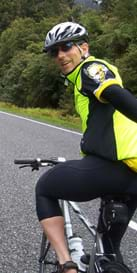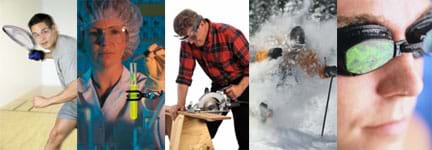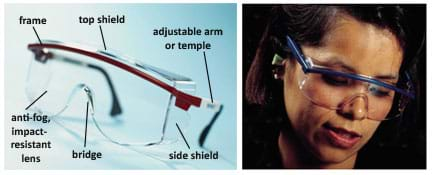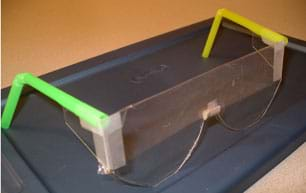
Summary
Students design and build prototypes for protective eyewear. They choose different activities or sports that require protective eyewear and design a device for that particular use. Students learn about the many ways in which the eyes can be damaged and how engineers incorporate different features and materials into eyewear designs to best protect the eyes.Engineering Connection
Engineers have been designing protective eyewear for centuries, with much improvement as new materials and technologies have become available. Today, many people protect their eyes while participating in jobs, sports and hobbies. Because the eyes have many sensitive parts and are so vital to everyday functioning, it is important for engineers to continue designing better protective eyewear to meet the needs of every activity in which the eyes may be at risk.
Learning Objectives
After this activity, students should be able to:
- Explain the important parts and functions of protective eyewear.
- Explain how the eyes can be damaged and why it is important to protect the eyes.
- Explain why engineers have chosen certain features and materials for protective eyewear.
Educational Standards
Each TeachEngineering lesson or activity is correlated to one or more K-12 science,
technology, engineering or math (STEM) educational standards.
All 100,000+ K-12 STEM standards covered in TeachEngineering are collected, maintained and packaged by the Achievement Standards Network (ASN),
a project of D2L (www.achievementstandards.org).
In the ASN, standards are hierarchically structured: first by source; e.g., by state; within source by type; e.g., science or mathematics;
within type by subtype, then by grade, etc.
Each TeachEngineering lesson or activity is correlated to one or more K-12 science, technology, engineering or math (STEM) educational standards.
All 100,000+ K-12 STEM standards covered in TeachEngineering are collected, maintained and packaged by the Achievement Standards Network (ASN), a project of D2L (www.achievementstandards.org).
In the ASN, standards are hierarchically structured: first by source; e.g., by state; within source by type; e.g., science or mathematics; within type by subtype, then by grade, etc.
NGSS: Next Generation Science Standards - Science
| NGSS Performance Expectation | ||
|---|---|---|
|
MS-ETS1-1. Define the criteria and constraints of a design problem with sufficient precision to ensure a successful solution, taking into account relevant scientific principles and potential impacts on people and the natural environment that may limit possible solutions. (Grades 6 - 8) Do you agree with this alignment? |
||
| Click to view other curriculum aligned to this Performance Expectation | ||
| This activity focuses on the following Three Dimensional Learning aspects of NGSS: | ||
| Science & Engineering Practices | Disciplinary Core Ideas | Crosscutting Concepts |
| Define a design problem that can be solved through the development of an object, tool, process or system and includes multiple criteria and constraints, including scientific knowledge that may limit possible solutions. Alignment agreement: | The more precisely a design task's criteria and constraints can be defined, the more likely it is that the designed solution will be successful. Specification of constraints includes consideration of scientific principles and other relevant knowledge that is likely to limit possible solutions. Alignment agreement: | All human activity draws on natural resources and has both short and long-term consequences, positive as well as negative, for the health of people and the natural environment. Alignment agreement: The uses of technologies and any limitations on their use are driven by individual or societal needs, desires, and values; by the findings of scientific research; and by differences in such factors as climate, natural resources, and economic conditions.Alignment agreement: |
| NGSS Performance Expectation | ||
|---|---|---|
|
MS-ETS1-2. Evaluate competing design solutions using a systematic process to determine how well they meet the criteria and constraints of the problem. (Grades 6 - 8) Do you agree with this alignment? |
||
| Click to view other curriculum aligned to this Performance Expectation | ||
| This activity focuses on the following Three Dimensional Learning aspects of NGSS: | ||
| Science & Engineering Practices | Disciplinary Core Ideas | Crosscutting Concepts |
| Evaluate competing design solutions based on jointly developed and agreed-upon design criteria. Alignment agreement: | There are systematic processes for evaluating solutions with respect to how well they meet the criteria and constraints of a problem. Alignment agreement: | |
International Technology and Engineering Educators Association - Technology
-
Students will develop an understanding of the attributes of design.
(Grades
K -
12)
More Details
Do you agree with this alignment?
-
Students will develop an understanding of engineering design.
(Grades
K -
12)
More Details
Do you agree with this alignment?
-
Develop innovative products and systems that solve problems and extend capabilities based on individual or collective needs and wants.
(Grades
6 -
8)
More Details
Do you agree with this alignment?
Materials List
Each group needs:
- plastic sheeting, 9 x 4-in (~23 x 10-cm) piece (much thinner than Plexiglas; available at hardware stores)
- cardboard or poster board, 9 x 6- in (~23 x 15-cm) piece
- white paper (for design and template)
- Protective Eyewear - Design Brainstorming Worksheet, one per person
- Engineering Design Report Template, one per person
For the entire class to share:
- colored plastic saran wrap
- colored and bendable plastic drinking straws
- popsicle sticks
- clear tape
- felt and rubber pieces
- string and yarn
- markers
- scissors
- ruler
- (optional) rubber bands, colored paper, play dough or modeling clay
- (optional, for extension activity) items for testing stations,, such as: fan; grass clippings; small, clean spray bottle and water; towel; flashlight
Worksheets and Attachments
Visit [www.teachengineering.org/activities/view/cub_biomed_lesson07_activity1] to print or download.Introduction/Motivation
Have any of you ever had an eye injury? Have you ever been poked in the eye? How did that feel? Did it take a lot of force to hurt your eye or just something tapping it?
What happens if someone claps in front of your eyes? (You automatically close them.) Closing your eyes is your body's reflex to protect your eyes because they are so vulnerable and important. Your eyelids also protect your eyes from objects or substances that might injure them. But sometimes our natural reflexes and our eyelids are not enough.
What might damage your eyes if it came in contact with them? (At their desks, have students write on pieces of paper five things that could damage a person's eyes. Ask the class to volunteer some of their answers. Make a list on the board. Possible answers: Sharp objects, chemicals, small objects, bugs, bright light, etc.) Can you think of any sports or activities in which you would want to wear eye protection? (Again, have students write down five things and make a combined class list on the board. Possible answers: Sports: snowboarding, mountain biking, swimming, dirt biking; activities/hobbies: chemistry set, paintballing, woodworking, mowing the lawn, welding.)

Okay, lets pick mountain biking (or choose any sport or activity) and think of all the risks to our eyes. What are some things that you might encounter while mountain biking that could damage or irritate your eyes? (Suggest that students imagine riding their bikes down a mountainside or on an off-road trail and think of what they might come across. Providing a specific context helps them brainstorm more ideas. Possible answers: Harsh wind can cause tearing and blurred vision, trail dirt and dust can irritate eyes and make them water or itch, small rocks and sand can be kicked up, low branches and vegetation can hang over the trail, bugs and plant matter in the air, UV rays from the sun, bright sunlight or glare from the sun, sweat dripping in your eyes, crashing and hitting your face. Write all the ideas on the board and ask students how each of these conditions might affect their eyes. Encourage students to name specific eye parts and the function[s] that could be damaged.)
Now, can you name any design features of protective eyewear that prevent our eyes from being hurt by each of these things? (Make another list on the board. Possible answers: Lenses that fit the shape of your face or wrap around the sides of your eyes, UV/polarized protective coating, color shaded lens, lens material that is scratch-resistant, shatter-proof and anti-fog, etc. Go through each item and have students name or explain how safety glasses could protect their eyes from these hazards. These become the design features; write them on the board, too.)
Okay, what are some other features that would be helpful in protective eyewear when mountain biking? (Possible answers: Light-weight so they do not weigh down the head, ergonomic design that fits well while wearing a helmet, strap around the head or spring force from the arms on the side of the head to keep them snug, ability to be cleaned, etc.)
All of these ideas are great! Now, we are going to split up into groups of two and choose a sport or activity for which you want to work as biomedical engineers to design protective eyewear.
Procedure
Background
See Figure 1 for the names of common components found in most safety glasses.

Before the Activity
- Gather materials and make copies of the Protective Eyewear – Design Brainstorming Worksheet and Engineering Design Report Template, one each per person.
- Discuss with students the importance of being cautious when working near the eyes. Instruct them not to grab the glasses off another student's face or work on them while they are being worn.
With the Students
- Divide the class into groups of two students each. Hand out the worksheets.
- Direct each team to choose a sport or activity for which they will design protective eyewear.
- Before passing out materials, have students complete the worksheet, identifying possible eye risks and hazards, determining desired features of their glasses that address the various hazards, and a sketching the design, labeled with parts and materials.
- When the designs are complete, give the students a sheet of paper with which to make a template for their glasses. Have them draw the shape of the glasses to size and cut it out to see how it fits their face.
- When students have found the right shape for their lens(es) and frame, through trial and error, give them the plastic sheet and other materials to make the eyewear (see example in Figure 2). Use the template to trace the lens shape onto the plastic sheet. Help students cut or manipulate any difficult material.
- As students are working, as engineers, let them know that they are creating prototypes — a first attempt or early design of a new product or creation. A prototype gets revised many, many, many times with much testing and improvement before it becomes a mass-produced, commercially-available product in the marketplace.

- (optional) To limit the amount of materials and simulate real-world design, assign a price for each material and have students purchase the materials, keeping to their budget. Limit the amount of money they receive. If groups do not work together, assess a penalty to reduce their funds; if they work well together, reward with monetary bonuses.
- (optional) Designate some of the plastic sheets as UV-protected lenses and charge slightly more. Do this with other features as well, such as shatter-proof or chemical-resistant lenses.
- When all groups are finished designing and creating their protective eyewear prototypes, have them write an engineering design report (hand out the report template forms), and present their designs to the class. Require them to explain their design advantages and possible improvements. If time permits, have students create a magazine ad or commercial that describes their product benefits.
- Consider conducting the activity extensions, to test the prototype eyewear or explore their protection from specific eye injuries. See the Activity Extensions section for details.
Vocabulary/Definitions
biomedical engineer: A person who blends traditional engineering techniques with the biological sciences and medicine to improve the quality of human health and life. Biomedical engineers design artificial body parts, medical devices, diagnostic tools, and medical treatment methods.
nose bridge: A part of eyewear that supports the glasses on the nose. It may be continuous or have a few pads.
polarized: Lenses that block glare in bright conditions, especially light reflecting from snow, water or car windows.
prototype: A first attempt or early design of a new product or creation. May be revised many times.
temple: A part of eyewear that wraps over the ear to hold the glasses to the face. Also called arm.
UV rays: Ultraviolet (UV) light from the sun is not visible, but can damage eyes and skin (cause "sunburn").
Assessment
Pre-Activity Assessment
Class Brainstorm: As a class, have the students engage in open discussion. Remind students that in brainstorming, no idea or suggestion is "silly." All ideas should be respectfully heard. Take an uncritical position, encourage wild ideas and discourage criticism of ideas. Have them raise their hands to respond. Write their ideas on the board. Ask students to list activities that require eye protection, conditions/objects/situations that can damage the eyes, and specific eyewear features that protect wearers from each potential hazard.
This process provides a good indication of how well the students understand the risks to the eyes and the various ways in which the parts of the eyes may be damaged. Obvious hazards include cutting or stabbing from sharp objects such as branches, but UV rays and glare, for example, are a little more subtle in their contact with or impact on the eyes.
Activity Embedded Assessment
Design Worksheet: Have students complete the Protective Eyewear - Design Brainstorming Worksheet, as they brainstorm for their protective eyewear designs. They demonstrate their understanding by listing the eye hazards and indicating which design features protect the eyes from these risks. They prepare to create a prototype by sketching their design and identifying the parts and materials.
Post-Activity Assessment
Engineering Design Report: Have students complete the Engineering Design Report Template to help them summarize and describe the best features of their final product and what they would improve if they were to re-design the eyewear. If time permits, have teams present their designs to the class.
Safety Issues
- Be cautious when working near the eyes, being careful not to grab the glasses off another student's face or work on them while they are being worn.
- If conducting the extension activity and testing the glasses with the squirt gun and the grass, be sure to have students close their eyes in case the glasses fail.
Activity Extensions
Create an Eyewear Testing Zone: Set up testing stations. Example tests: Squirting water from a small spray bottle to see if it reaches the eyes, tossing a little grass at the glasses to see if it gets in on the sides or tops, blowing a fan towards the glasses to see if the wind reaches the eyes and makes them tear, and shining a flashlight at the glasses to see how well they dim the light.
Specific Eye Injuries: After the students explain or present their protective eyewear designs, pick a couple of the possible injuries that might occur in their sports or activities and ask them which parts of the eye would be hurt, and what functions of the eye would be hindered. Have students explain how engineers could design to specifically offer protection from injury.
Reverse Engineering: Assign students to bring from home examples of protective eyewear for "show and tell" to the class. Have students point out the parts, materials and features that make the designs uniquely suitable for specific activities. Have other classmates contribute their ideas on the logic behind the engineering designs.
Activity Scaling
- For lower grades, provide more guidance during the design process and help with eyewear construction.
- For upper grades, require more detailed designs, have students build more robust and functional prototypes to test certain features, and require them to document final designs on paper with specification details and features labeled. Use more durable and precise materials to create the glasses. Provide small screws, springs, Plexiglas, pins and hinges, as well as tools such as screwdrivers and a dremel tool.
Subscribe
Get the inside scoop on all things TeachEngineering such as new site features, curriculum updates, video releases, and more by signing up for our newsletter!More Curriculum Like This

Students learn about the function and components of the human nervous system, which helps them understand the purpose of our brains, spinal cords, nerves and five senses. In addition, how the nervous system is affected during spaceflight is also discussed.

Students examine the structure and function of the human eye, learning some amazing features about our eyes, which provide us with sight and an understanding of our surroundings. Students also learn about some common eye problems and the biomedical devices and medical procedures that resolve or help...
Copyright
© 2008 by Regents of the University of ColoradoContributors
William Surles; Lesley Herrmann; Malinda Schaefer Zarske; Denise W. CarlsonSupporting Program
Integrated Teaching and Learning Program, College of Engineering, University of Colorado BoulderAcknowledgements
The contents of this digital library curriculum were developed under grant sfrom the Fund for the Improvement of Postsecondary Education (FIPSE), U.S. Department of Education and National Science Foundation (GK-12 grant no. 0338326). However, these contents do not necessarily represent the policies of the Department of Education or National Science Foundation, and you should not assume endorsement by the federal government.
Last modified: March 15, 2020









User Comments & Tips